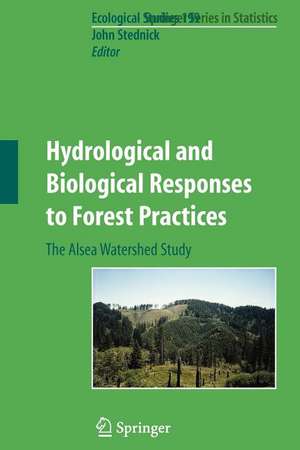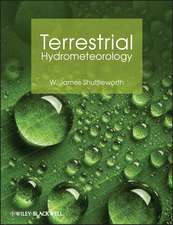Hydrological and Biological Responses to Forest Practices: The Alsea Watershed Study: Ecological Studies, cartea 199
Editat de John D. Stednicken Limba Engleză Paperback – 19 noi 2010
| Toate formatele și edițiile | Preț | Express |
|---|---|---|
| Paperback (1) | 946.24 lei 6-8 săpt. | |
| Springer – 19 noi 2010 | 946.24 lei 6-8 săpt. | |
| Hardback (1) | 950.52 lei 6-8 săpt. | |
| Springer – 10 dec 2007 | 950.52 lei 6-8 săpt. |
Din seria Ecological Studies
- 18%
 Preț: 1118.93 lei
Preț: 1118.93 lei -
 Preț: 553.71 lei
Preț: 553.71 lei - 18%
 Preț: 1680.55 lei
Preț: 1680.55 lei - 18%
 Preț: 1003.38 lei
Preț: 1003.38 lei - 20%
 Preț: 1004.69 lei
Preț: 1004.69 lei -
 Preț: 480.62 lei
Preț: 480.62 lei - 5%
 Preț: 752.26 lei
Preț: 752.26 lei - 15%
 Preț: 643.99 lei
Preț: 643.99 lei - 15%
 Preț: 644.18 lei
Preț: 644.18 lei - 15%
 Preț: 652.49 lei
Preț: 652.49 lei - 18%
 Preț: 789.83 lei
Preț: 789.83 lei -
 Preț: 382.36 lei
Preț: 382.36 lei - 15%
 Preț: 643.48 lei
Preț: 643.48 lei - 15%
 Preț: 646.30 lei
Preț: 646.30 lei - 15%
 Preț: 634.32 lei
Preț: 634.32 lei -
 Preț: 384.86 lei
Preț: 384.86 lei - 18%
 Preț: 789.98 lei
Preț: 789.98 lei - 15%
 Preț: 645.14 lei
Preț: 645.14 lei - 15%
 Preț: 649.39 lei
Preț: 649.39 lei - 18%
 Preț: 1005.43 lei
Preț: 1005.43 lei - 18%
 Preț: 949.23 lei
Preț: 949.23 lei - 15%
 Preț: 649.54 lei
Preț: 649.54 lei - 15%
 Preț: 643.34 lei
Preț: 643.34 lei - 15%
 Preț: 649.71 lei
Preț: 649.71 lei - 15%
 Preț: 638.76 lei
Preț: 638.76 lei - 18%
 Preț: 957.62 lei
Preț: 957.62 lei - 18%
 Preț: 1235.25 lei
Preț: 1235.25 lei - 18%
 Preț: 962.18 lei
Preț: 962.18 lei - 18%
 Preț: 949.23 lei
Preț: 949.23 lei - 15%
 Preț: 660.68 lei
Preț: 660.68 lei -
 Preț: 397.76 lei
Preț: 397.76 lei - 15%
 Preț: 638.24 lei
Preț: 638.24 lei - 18%
 Preț: 942.31 lei
Preț: 942.31 lei - 18%
 Preț: 1232.57 lei
Preț: 1232.57 lei - 15%
 Preț: 651.34 lei
Preț: 651.34 lei - 18%
 Preț: 952.72 lei
Preț: 952.72 lei - 18%
 Preț: 1834.27 lei
Preț: 1834.27 lei - 18%
 Preț: 1229.10 lei
Preț: 1229.10 lei -
 Preț: 423.95 lei
Preț: 423.95 lei - 18%
 Preț: 948.92 lei
Preț: 948.92 lei
Preț: 946.24 lei
Preț vechi: 1153.95 lei
-18% Nou
Puncte Express: 1419
Preț estimativ în valută:
181.07€ • 189.52$ • 150.70£
181.07€ • 189.52$ • 150.70£
Carte tipărită la comandă
Livrare economică 01-15 aprilie
Preluare comenzi: 021 569.72.76
Specificații
ISBN-13: 9781441928436
ISBN-10: 144192843X
Pagini: 332
Ilustrații: XIV, 322 p. 85 illus.
Dimensiuni: 155 x 235 x 17 mm
Greutate: 0.47 kg
Ediția:Softcover reprint of hardcover 1st ed. 2008
Editura: Springer
Colecția Springer
Seria Ecological Studies
Locul publicării:New York, NY, United States
ISBN-10: 144192843X
Pagini: 332
Ilustrații: XIV, 322 p. 85 illus.
Dimensiuni: 155 x 235 x 17 mm
Greutate: 0.47 kg
Ediția:Softcover reprint of hardcover 1st ed. 2008
Editura: Springer
Colecția Springer
Seria Ecological Studies
Locul publicării:New York, NY, United States
Public țintă
ResearchCuprins
The Alsea Watershed Study.- Effects of Timber Harvesting on Streamflow in the Alsea Watershed Study.- Stream Temperature and Dissolved Oxygen.- Forest Practices and Sediment Production in the Alsea Watershed Study.- Salmonid Populations and Habitat.- The Oregon Forest Practices Act and Forest Research.- The New Alsea Watershed Study.- Flynn Creek: Research Natural Area.- Long-term Streamflow Changes Following Timber Harvesting.- Long-term Water Quality Changes Following Timber Harvesting.- Risk Assessment for Salmon from Water Quality Changes Following Timber Harvesting.- Sedimentation Studies Following the Alsea Watershed Study.- Woody Debris from the Streamside Forest and its Influence on Fish Habitat.- Long-term Trends in Habitat and Fish Populations in the Alsea Basin.- The Alsea Watershed Study: A Comparison with Other Multi-year Investigations in the Pacific Northwest.- Watershed Management.- Research Opportunities in Hydrology and Biology in Future Watershed Studies.
Recenzii
From the reviews:
"This work, volume 199 in the ‘Ecological Studies’ series, includes 15 years of research, 20 years of monitoring data, and a research renewal focusing on the Alsea watershed habitat and organism responses to four decades of forest practices. … Chapters contain graphs, figures, and tables to emphasize and illustrate important concepts. Suitable for soil scientists, biologists (wildlife, fishery), limnologists, foresters, hydrologists, conservationists, and professionals involved with forestland use policy and problems. Summing Up: Recommended. Upper-division undergraduate through professional collections." (S. G. Shetron, CHOICE, Vol. 45 (11), 2008)
"This work, volume 199 in the ‘Ecological Studies’ series, includes 15 years of research, 20 years of monitoring data, and a research renewal focusing on the Alsea watershed habitat and organism responses to four decades of forest practices. … Chapters contain graphs, figures, and tables to emphasize and illustrate important concepts. Suitable for soil scientists, biologists (wildlife, fishery), limnologists, foresters, hydrologists, conservationists, and professionals involved with forestland use policy and problems. Summing Up: Recommended. Upper-division undergraduate through professional collections." (S. G. Shetron, CHOICE, Vol. 45 (11), 2008)
Textul de pe ultima copertă
The Alsea Watershed Study, established in 1959 and reactivated in 1989 as the New Alsea Watershed Study, evaluated the effects of timber harvesting on water resources and salmonid habitat and populations in the temperate coniferous forests of the Oregon Coast Range. This was the first paired watershed experiment to focus on aquatic habitat and organism response to forest practices. Demonstrating the importance of maintaining streamside vegetation in protecting water quality and fish habitat during timber harvest operations, the study led directly to regulations in the Oregon Forest Practices Act of 1971 that required leaving streamside vegetation in harvest units. Decades of research have provided important information and lessons for watershed research and management.
Through analyses of works generated by the study, Hydrological and Biological Responses to Forest Practices: The Alsea Watershed Study addresses the quantification of forest resource sustainability and bolsters the case for long-term monitoring at a time when managers and policy makers are searching for ways to restore the runs of salmon and steelhead to rivers and streams of the Pacific Northwest. Edited by John D. Stednick, a forest hydrologist responsible for the study’s reactivation, this book will be of interest to students in natural resources, land managers, policy makers, and researchers, particularly in water and fishery resources.
About the Editor: John D. Stednick is a professor of Watershed Science at Colorado State University in Fort Collins, CO.
Through analyses of works generated by the study, Hydrological and Biological Responses to Forest Practices: The Alsea Watershed Study addresses the quantification of forest resource sustainability and bolsters the case for long-term monitoring at a time when managers and policy makers are searching for ways to restore the runs of salmon and steelhead to rivers and streams of the Pacific Northwest. Edited by John D. Stednick, a forest hydrologist responsible for the study’s reactivation, this book will be of interest to students in natural resources, land managers, policy makers, and researchers, particularly in water and fishery resources.
About the Editor: John D. Stednick is a professor of Watershed Science at Colorado State University in Fort Collins, CO.
Caracteristici
Contains information gleaned from the original Alsea Watershed Study and the “new” study of 20 years later Includes analyses and syntheses of other relevant work, much of which originated from questions generated by the original study Represents the cooperative effort of many scientists from several disciplines. It comes at a time when mangers and policy makers are searching for ways to restore the runs of salmon and steelhead to rivers and streams of the Pacific Northwest Includes supplementary material: sn.pub/extras





